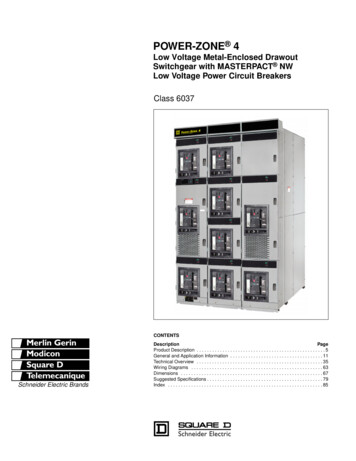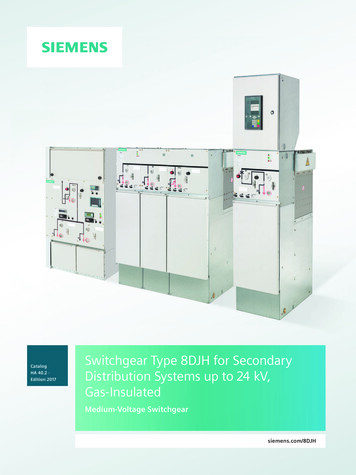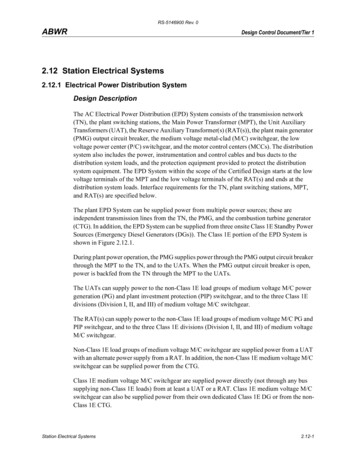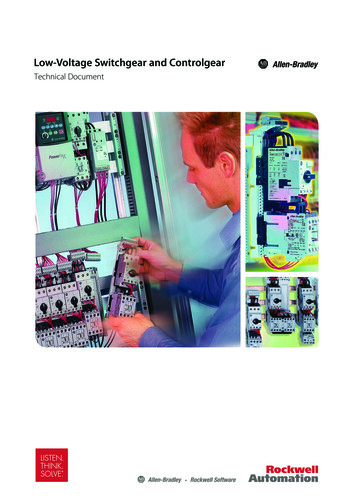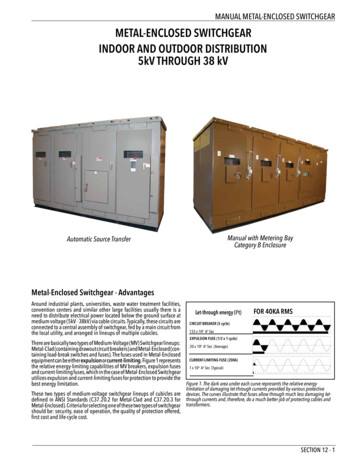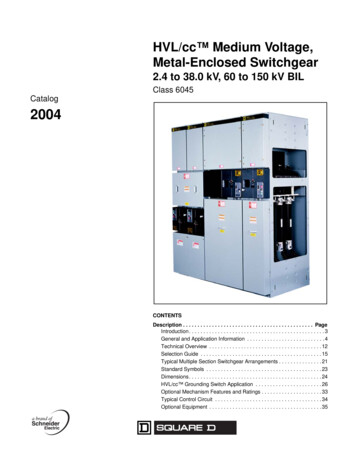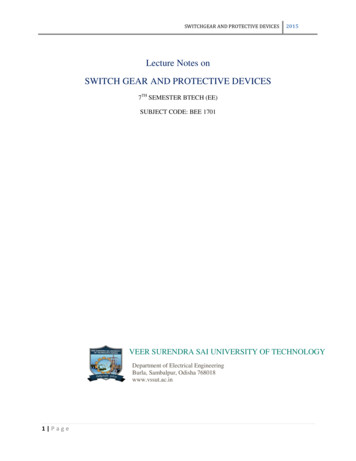
Transcription
SWITCHGEAR AND PROTECTIVE DEVICES2015Lecture Notes onSWITCH GEAR AND PROTECTIVE DEVICES7TH SEMESTER BTECH (EE)SUBJECT CODE: BEE 1701VEER SURENDRA SAI UNIVERSITY OF TECHNOLOGYDepartment of Electrical EngineeringBurla, Sambalpur, Odisha 768018www.vssut.ac.in1 Page
SWITCHGEAR AND PROTECTIVE DEVICES2015DISCLAIMERThis document does not claim any originality and cannot be used as a substitute forprescribed textbooks. The information presented here is merely a collection by the committeemembers for their respective teaching assignments. Various sources as mentioned at the end ofthe document as well as freely available material from internet were consulted for preparing thisdocument. The ownership of the information lies with the respective authors or institutions.Further, this document is not intended to be used for commercial purpose and the committeemembers are not accountable for any issues, legal or otherwise, arising out of the use of thisdocument. The committee members make no representations or warranties with respect to theaccuracy or completeness of the contents of this document and specifically disclaim any impliedwarranties of merchantability or fitness for a particular purpose. The committee members shallnot be liable for any loss of profit or any other commercial damages, including but not limited tospecial, incidental, consequential, or other damages.2 Page
SWITCHGEAR AND PROTECTIVE DEVICES2015SYLLABUSSWITCHGEAR AND PROTECTIVE DEVICES (3-1-0)MODULE-I (10 HOURS)Protective Devices: Philosophy of protection, Nature, Causes and consequences of faults, Zone ofprotection, Requirements of a protective scheme, Basic terminology components of protection scheme.Relay classification, Principle of different types of electromagnetic relay. General equation of phase andmagnitude comparators, Duality of comparators, Electromagnetic relays, over current relays Directionalrelays, Distance relay- impedance, Reactance and Mho type, Differential relays.MODULE-II (10 HOURS)Feeder: Protection: Over current and earth fault protection, Distance protection, Pilot wire protection,Carrier current protection.Generator Protection: Biased differential protection, restricted earth fault protection, Field suppression,Negative sequence protection, Earth fault detection in rotor circuitPower transformer Protection: Biased differential protections, restricted earth fault protection, Buchholzrelay Protection of combined transformer and alternator.Bus Zone Protection: frame leakage and circulating current scheme-use of Translay relay.MODULE-III (10 HOURS)Circuit Breakers: Formation of arc during circuit breaking. Characteristics of electric arc. Theories of arcInterruption. Recovery and restriking voltage, interruption of capacitive and inductive currents. Currentchopping. Principle of A.C. and D.C. circuit breaking requirements of good circuit breaker circuit breakerrating.Different types of circuit breakers. Air break and Air blast circuit breaker. Plain break and controlledbreak all circuit breakers. Minimum oil circuit breakers. Vacuum circuit breaker, SF6 circuit breaker.D.C. Circuit breaker.H.R.C. Fuse: Construction and characteristicsMODULE-IV (10 HOURS)Static Relays : Development and classification of static relays, Different types of phase and amplitudecapacitors, Basic static relays used in protective scheme, Elementary idea about digital & numericalprotection. Testing and maintenance of protective gear, Protection against surge-surge absorber, Surgediverter.Arrangement of Bus bar, Circuit breaker and isolator. Current limiting reactors in power system and theirarrangement calculation of fault MVA for symmetrical short circuits. Circuit breaker capacity.3 Page
SWITCHGEAR AND PROTECTIVE DEVICES2015BOOKS[1]. Van C Warrington, “Protective Relays” Vol.-I & II[2]. Ravindranath, M.Chander, “Power System Protection and SwitchGear”, Wiley Eastern Ltd. NewDelhi[3]. T S Madhav Rao, “Power System Protection”, TMH Pulication[4]. Sunil S.Rao, “Switch Gear and Protection”, Khanna Publication4 Page
SWITCHGEAR AND PROTECTIVE DEVICESMODULE-ILesson Plan1.1Fundamentals of Power System Protection1.2 Consequences of occurrence of fault1.3 Zones of Protection1.4 Protection System Requirements and some basic terminologies used1.5 Classification and principle of different types of electromagnetic relays1.6 Over current relays1.7 Directional relay1.8 Distance relay1.9 Differential relay1.10 General equation of Comparators and the duality principle5 Page2015
SWITCHGEAR AND PROTECTIVE DEVICES20151.1 Fundamentals of Power System ProtectionThe purpose of an Electric Power System is to generate and supply electrical energy toconsumers. The power system should be designed and managed to deliver this energy to theutilization points with both reliability and economicallyThe capital investment involved in power system for the generation, transmission anddistribution is so great that the proper precautions must be taken to ensure that the equipment notonly operates as nearly as possible to peak efficiency, but also must be protected from accidentsThe normal path of the electric current is from the power source through copper (or aluminium)conductors in generators, transformers and transmission lines to the load and it is confined to thispath by insulation. The insulation, however, may break down, either by the effect of temperatureand age or by a physical accident, so that the current then follows an abnormal path generallyknown as Short Circuit or Fault Any abnormal operating state of a power system is known as FAULT. Faults in generalconsist of short circuits as well as open circuits. Open circuit faults are less frequent thanshort circuit faults, and often they are transformed in to short circuits by subsequentevents.6 Page
SWITCHGEAR AND PROTECTIVE DEVICES20151.2 Consequences of occurrence of FaultsFaults are of two type Short circuit fault- current Open circuit fault- voltageIn terms of seriousness of consequences of a fault , short circuits are of far greater concernthan open circuits, although some open circuits present some potential hazards to personnelClassification of short circuited Faults Three phase faults (with or without earth connection) Two phase faults (with or without earth connection) Single phase to earth faultsClassification of Open Circuit Faults Single Phase open Circuit Two phase open circuit Three phase open circuitConsequences Damage to the equipment due to abnormally large and unbalanced currents and lowvoltages produced by the short circuits Explosions may occur in the equipments which have insulating oil, particularly duringshort circuits. This may result in fire and hazardous conditions to personnel andequipments Individual generators with reduced voltage in a power station or a group of generatorsoperating at low voltage may lead to loss of synchronism, subsequently resulting inislanding.7 Page
SWITCHGEAR AND PROTECTIVE DEVICES 2015Risk of synchronous motors in large industrial premises falling out of step and trippingout.The general layout of a protection system may be viewed as given in the following figure1.3 Zones and types of Protection system1.3.1 Zones of Protection system An electric power system is divided into several zones of protection. Each zone ofprotection, contains one or more components of a power system in addition to two circuitbreakers. When a fault occurs within the boundary of a particular zone, then the protection systemresponsible for the protection of the zone acts to isolate (by tripping the Circuit Breakers)every equipment within that zone from the rest of the system. The circuit Breakers are inserted between the component of the zone and the rest of thepower system. Thus, the location of the circuit breaker helps to define the boundaries ofthe zones of protection.8 Page
SWITCHGEAR AND PROTECTIVE DEVICES 2015Different neighbouring zones of protection are made to overlap each other, which ensurethat no part of the power system remains withoutprotection. However, occurrence ofthe fault with in the overlapped region will initiate a tripping sequence of differentcircuit breakers so that the minimum necessary to disconnect the faulty element1.3.29 PageTypes of Protection (Primary and Back-up Protection)
SWITCHGEAR AND PROTECTIVE DEVICES20151.3.2.1 Primary Protection– The primary protection scheme ensures fast and selective clearing of any faultwithin the boundaries of the circuit element, that the zone is required to protect.Primary Protection as a rule is provided for each section of an electricalinstallation.However, the primary protection may fail. The primary cause of failure of the Primary Protectionsystem are enumerated below.1. Current or voltage supply to the relay.2. D.C. tripping voltage supply3. Protective relays4. Tripping circuit5. Circuit Breaker1.3.2.2Back-up ProtectionBack-up protection is the name given to a protection which backs the primaryprotection whenever the later fails in operation. The back-up protection by definition is slowerthan the primary protection system.The design of the back-up protection needs to becoordinated with the design of the primary protection and essentially it is the second line ofdefence after the primary protection system.1.4 Protection System Requirements and some basic terminologies used The fundamental requirements for a protection system are as follows:1.4.1 Reliability: It is the ability of the protection system to operate correctly. The reliabilityfeature has two basic elements, which are dependability and security. The dependabilityfeature demands the certainty of a correct operation of the designed system, onoccurrence of any fault. Similarly, the security feature can be defined as the ability of thedesigned system to avoid incorrect operation during faults. A comprehensive statistical10 P a g e
SWITCHGEAR AND PROTECTIVE DEVICES2015method based reliability study is required before the protection system may becommissioned. The factors which affect this feature of any protection system dependson some of the following few factors.a) Quality of Component usedb) Maintenance schedulec) The supply and availability of spare parts and stocksd) The design principlee) Electrical and mechanical stress to which the protected part of the system issubjected to.1.4.2 Speed: Minimum operating time to clear a fault in order to avoid damage to equipment.The speed of the protection system consists primarily of two time intervals of interest.a) The Relay Time : This is the time between the instant of occurrence of the fault to theinstant at which the relay contacts open.b) The Breaker Time: This is the time between the instant of closing of relay contacts tothe instant of final arc extinction inside the medium and removal of the fault.1.4.3 Selectivity: This feature aims at maintaining the continuity of supply system bydisconnecting the minimum section of the network necessary to isolate the fault. Theproperty of selective tripping is also known as “discrimination”. This is the reason forwhich the entire system is divided into several protective zones so that minimum protionof network is isolated with accuracy. Two examples of utilization of this feature in arelaying scheme are as followsa)Time graded systemsb)Unit systems1.4.4. Sensitivity: The sensitivity of a relay refers to the smallest value of the actuating quantityat which the relay operates detecting any abnormal condition. In case of an overcurrent11 P a g e
SWITCHGEAR AND PROTECTIVE DEVICES2015relay, mathematically this can be defined as the ratio between the short circuit fault current(Is) and the relay operating current (Io). The value of Io , should not be too small or large sothat the relay is either too sensitive or slow in responding.1.4.5 Stability: It is the quality of any protection system to remain stable within a set of definedoperating scenarios and procedures. For example the biased differential scheme ofdifferential protection is more stable towards switching transients compared to the moresimple and basic Merz Price scheme in differential protection1.4.6 Adequacy: It is economically unviable to have a 100% protection of the entire system inconcern. Therefore, the cost of the designed protection system varies with the criticalityand importance of the protected zone. The protection system for more critical portionsis generally costly, as all the features of a good protection system is maximized here.But a small motor can be protected by a simple thermally operated relay, which issimple and cheap. Therefore, the cost of the protection system should be adequate in itscost.1.4.7 Some basic terminologies used in protection systemSome basic terminologies commonly used in the protection system are enlisted below.i) Measuring Relay ii) Fault Clearing Time iii) Auxilliary relay iv) Relay Time v) Pick upvalue vi) Reset Value vii) Drop out viii) Reach ( under and over reaches) ix) RelayBurden x) Unit/ Non unit protection xi) All or Nothing relay1.5 Classification and construction of relays1.5.1 ClassificationProtection relays can be primarily classified in accordance with their construction, the actuatingsignal and application and function1.5.1.1 According to the Construction principle12 P a g e
SWITCHGEAR AND PROTECTIVE DEVICES2015Depending upon the principle of construction, the following four brad categories are found. Electromechanical Solid State Microprocessor Numerical1.5.1.2 According to the actuating signalsThe actuating signal may be any of the following signals including a numbers of differentcombinations of these signals depending upon whether the designed relay require a single ormultiple inputs for its realization. Current Voltage Power Frequency Temperature Pressure Speed Others1.5.1.3 FunctionThe functions for which the protection system is designed classify the relays in the following fewcategories. Directional Over current Distance13 P a g e
SWITCHGEAR AND PROTECTIVE DEVICES Over voltage Differential Reverse Power Others2015It is important to notice that the same set of input actuating signals may be utilized to design torelays having different function or application. For example, the voltage and current input relayscan be designed both as a Distance and/ or a Reverse Power relay.Electromechanical relaysThese relays are constructed with electrical, magnetic & mechanical components & have anoperating coil & various contacts,& are very robust & reliable. Based on the construction,characteristics, these are classified in three groups.Attraction relaysAttraction relays can be AC & DC and operate by the movement of a piece of iron when it isattracted by the magnetic field produced by a coil. There are two main types of relays:1. The attracted armature type2. Solenoid type relayAttracted armature relays Consists of a bar or plate (made of iron) that pivots when it is attracted towards the coil. The armature carries the moving part of the contact ,which is closed or opened, accordingto the design, when the armature is attracted to the coil.14 P a g e
SWITCHGEAR AND PROTECTIVE DEVICES2015Solenoid type relaysIn this a plunger or a piston is attracted axially within the field of the solenoid. In this case, thepiston carries the moving contacts.The force of attraction 15 P a g eK1I 2 K2
SWITCHGEAR AND PROTECTIVE DEVICESWhere, K12015depends on The number of turns of the coil The air gap The effective area The reluctance of the magnetic circuitK2 is the restraining force, usually produced by springFor threshold or balanced condition, the resultant force is zero.2K K21IIn order to control the value of current at which relay operates, the parameters K 1 and K2 mayadjusted. Attraction relays effectively have no time delay and are widely used wheninstantaneous operation is required.Relays with movable coilsThis type of relay consists of a rotating movement with a small coil suspended or pivoted withthe freedom to rotate between the poles of a permanent magnet. The coil is restrained by twospecial springs which also serve as connections to carry the current to the coil.16 P a g e
SWITCHGEAR AND PROTECTIVE DEVICES2015The torque produced in the coil isT BlaNiWhere,T TorqueB flux densityl length of the coila distance between the two sides of the coili current flowing through the coilN number of turns in the coil The relay has inverse type characteristicInduction relays An induction relay works only with AC It consists of an electromagnetic system Which operates on a moving conductor,generally in the form of a DISC or CUPProduction of actuating torque17 P a g e
SWITCHGEAR AND PROTECTIVE DEVICES2015Various quantities are shown at instant when Both fluxes are directed downward Are increasing in magnitudeLet ()t sin( t)1m1It may be assumed with negligible error that the paths in which rotor current flow havenegligible self inductance.F F2 F1Since sinusoidal flux waves are assumed, we may substitute the rms values of the fluxes for thecrest values in the above equation.F in m1m2s It may be noted that the net force is same at every instant. The net force is directed from the point where the leading flux process the rotor towardsthe point where the lagging flux pierces the rotor. Actuating force is produced in the presence of out of phase fluxes.18 P a g e
SWITCHGEAR AND PROTECTIVE DEVICES 2015Maximum force is produced when θ 90oClassification of induction relays1. Shaded pole relay2. Watthour- meter type relay3. Cup type relayThe air gap flux produced by the current flowing in a single coil is split into two out ofphase components by a so called „Shading Ring‟ generally of copper, that encircles part of thepole face of each pole at the air gap. The shading ring may be replaced by coils if control of operation of the shaded pole relayis desired. The inertia of the disc provides the time delay characteristics.19 P a g e
SWITCHGEAR AND PROTECTIVE DEVICES2015Watt hour –meter structure This structure gets its name from the fact that it is used in watt hour meters. As shown in the top figure below, it contains two separate coils on two different magneticcircuit, each of which produces one of two necessary fluxes for driving the rotor, which isalso a disc20 P a g e
SWITCHGEAR AND PROTECTIVE DEVICES2015Induction-cup This type of relay has a cylinder similar to a cup which can rotate in the annular air gapbetween the poles & the fixed central core. The figure is shown above. The operation of this relay is similar to that of an induction motor with salient poles forthe windings of the stator. The movement of the cup is limited to a small amount by the contact & the stops. A special spring provides restraining torque. The cup type of relay has a small inertia & is therefore principally used when high speedoperation is required, for example in instantaneous units.General Torque equation of RelayBefore understanding about different other relays, it is first necessary to know thegeneral torque equation that defines any relay. The following equation defines torque in general.T K1 I 2 K 2V 2 K 3VI Cos( ) K 4Where, θ is the power factor angle and τ is the angle of maximum torque.As seen from the equation, the component of torques may be proportional to current,voltage, power and combination of the three quantities. The constant K4 is meant for the springconstant of the relay. Depending upon the type of relay, the one or several of the four constantsK1–K4 are either zero or non zero. In the subsequent discussions this will be elaborated whendifferent types of relays are discussed.1.6 Overcurrent Relays Protection against excess current was naturally the earliest protection systems to evolve From this basic principle has been evolved the graded over current system, a discriminatefault protection. “over current” protection is different from “over load protection”.21 P a g e
SWITCHGEAR AND PROTECTIVE DEVICES 2015Overload protection makes use of relays that operate in a time related in some degree tothe thermal capability of the plant to be protected. Over current protection, on the other hand, is directed entirely to the clearance of thefaults, although with the settings usually adopted some measure of overload protection isobtained. In terms of the general torque equation the over current relay has both constants K2 andK3 equal to zero. Therefore, the equation becomesT K1 I 2 K 41.6.1 Types of over current relays Based on the relay operating characteristics , overcurrent relays can be classified intothree groups–Definite current or instantaneous–Definite time–Inverse timeDEFINITE-CURRENT RELAYS This type of relay operates instantaneously when the current reaches a predeterminedvalue.DEFINITE TIME CURRENT RELAYS22 P a g e
SWITCHGEAR AND PROTECTIVE DEVICES 2015This type of relay operates after a definite time when the current reaches a predetermined value.INVERSE TIME RELAYS The fundamental property of these relays is that they operate in a time that is inverselyproportional to the fault current. Inverse time relays are generally classified in accordancewith their characteristic curve that indicates the speed of operation. Inverse-time relays are also referred as inverse definite minimum time or IDMT overcurrent relaysSETTING THE PARAMETERS OF TIME DELAY OVERCURRENT RELAYPick-up settingThe pick-up setting, or plug setting, is used to define the pick-up current of the relay, andfault currents seen by the relay are expressed as multiples of plug setting. Plug setting multiplier (PSM) is defined as the ratio of the fault current in secondaryAmps to the relay plug setting. For phase relays the pick-up setting is determined by allowing a margin for overloadabove the nominal current, as in the following expressionPick-up setting (OLF x Inom) / CTRWhere,OLF Overload factor that depends on the element being protected.Inom Nominal circuit current rating, andCTR CT RatioTime dial setting The time-dial setting adjusts the time –delay before the relay operates whenever the faultcurrent reaches a value equal to, or greater than the relay setting. The time-dial setting is also referred to as time multiplier setting (TMS)DISCRIMINATION BY TIME23 P a g e
SWITCHGEAR AND PROTECTIVE DEVICES2015In this method an appropriate time interval is given by each of the relays controlling the CBsin a power system to ensure that the breaker nearest to the fault location opens first.A simple radial distribution system is considered to illustrate this principleA radial distribution system with time-discrimination The main disadvantage of this method of discrimination is that the longest fault clearancetime occurs for faults in the section closest to the power source, where the fault level ishighest.DISCRIMINATION BY CURRENT Discrimination by current relies on the fact that the fault current varies with the positionof the fault, because of the difference in impedance values between the source and thefault. The relays controlling CBs are set to operate at suitably tapered values such that only therelay nearest the fault trips its circuit breaker.Inverse time over current relay characteristic is evolved to overcome the limitations imposed bythe independent use of either time or over current coordination.24 P a g e
SWITCHGEAR AND PROTECTIVE DEVICES20151.7 Directional Over Current Relays1. When fault current can flow in both the directions through the relay, at its location.Therefore, it is necessary to make the relay respond for a particular defined direction, sothat proper discrimination is possible. This can be achieved by introduction of directionalcontrol elements.2. These are basically power measuring devices in which the system voltage is used as areference for establishing the relative phase of the fault current.Basically, an AC directional relay can recognize certain difference in phase angle betweentwo quantities, just as a D.C. directional relay recognize difference in polarity1.7.1The polarizing quantity of a directional relay1. It is the reference against which the phase angle of the other quantity is compared.Consequently the phase angle of the polarizing quantity must remain fixed when otherquantity suffers wide change in phase angle.2. The voltage is chosen as the “polarizing” quantity in the current-voltage induction typedirectional relay.3. Four pole induction cup construction is normally used.1.8 Distance relayDistance relay is used for the protection of transmission line & feedersIn a distance relay, instead of comparing the local line current with the current at far endof line, the relay compares the local current with the local voltage in the correspondingphase or suitable components of them1.8.1Principle of operation of distance relay1. The basic principle of measurement involves the comparison of fault current seen by therelay with the voltage at relaying point; by comparing these two quantities.25 P a g e
SWITCHGEAR AND PROTECTIVE DEVICES2. It is possible to determine whether the2015impedance of the line up to the point of fault isgreater than or less than the predetermined reach point impedanceThere are two types of torques1. Restraining torqueTr VF22. Operating torqueT0 I 2FThe relay trips when T0 greater than TrKI F2 VF2VF IFKThe constant K depends on the design of the electromagnets.1.8.2 Types of distance relayDistance relays are classified depending on their operating characteristic in the R-Xplane Impedance Relay Mho Relay Reactance RelayIMPEDANCE RELAY:The torque equation T, for such a relay the current actuates the operating torque andthe voltage actuates the restraining torque, with the usual spring constant K4.T K1 I 2 K 2V 2 K 426 P a g e
SWITCHGEAR AND PROTECTIVE DEVICES2015Considering K2 to be negative (as it produces the restraining torque) and neglecting the torquecomponent due to spring, the equation represents a circle in the R-X plane.DISADVANTAGE OF IMPEDANCE RELAY1. It is not directional.2.It is affected by the Arc resistance3.It is highly sensitive to oscillations on the power system, due to large area covered by itscircular characteristicREACTANCE RELAYThe reactance relay is basically a directional restrained overcurrent relay. Therefore, theactuating quantity is current and the equation becomes as follows, where the constant K2 is zero.T K1 I 2 K 3VI Cos( ) K 427 P a g e
SWITCHGEAR AND PROTECTIVE DEVICES2015In the above equation, constant K1 is positive as the current produces operating torqueand K3 is negative as the power direction produces restraining torque. In the aboveequation the angle τ is considered as 900. So the equation derives toT K1 I 2 K 3VI Cos( 90 ) K 4 0Simplified toKVSin 1 ,IK3K1which gives ZSin X K in the R-X plane. The characteristics3resembles a horizontal line parallel to the R-axis with constant X value. The portionbelow the line gives the operating zone of the relay.1. The reactance relay is designed to measure only reactive component of the line reactance.2. The fault resistance has no affect on the reactance relayMHO RELAYThe Mho relay combines the properties of impedance and directional relays. Its characteristic isinherently directional and the relay only operates for faults in front of the relay location. In termsof the torque equation the relay characteristics can be obtained by making the constant K1 equalto zero. It is basically a voltage restrained directional relay and the torque equation becomes.T K 3VI Cos( ) K 2V 2 K 4 0Simplifying,K3K4VCos( ) Z Z ,SinceK2K 2VIIFurther, neglecting the spring constant K4,Z Z R Cos ( )The above equation actually is defined by circle, whose circle is offset from the origin which hasK3a diameter of Z R K . This relay has a larger coverage of R-X plane and therefore it is least2affect ted by condition of power swing. The characteristics is shown below.28 P a g e
SWITCHGEAR AND PROTECTIVE DEVICES1.92015Differential RelayOne of the most prevalent and successful method of protecting a circuit is to arrange relays tocompare the currents entering and leaving it, which should be the same under normal conditionsand during an external fault. Any difference current must be flowing in to a fault within theprotected circuit1.9.1Principle of circulating current differential (MERZ-PRIZE) protectionThe figure below illustrates the principle of differential protection of generator andtransformer, X is the winding of the protected machine. Where there is no internal fault, thecurrent entering in X is equal in phase and magnitude to current leaving X. The CT's have such aratio that during the normal conditions or for external faults (Through Faults) the secondarycurrent of CT's are equal. These current say I1 and I2 circulate in the pilot wire. The polarityconnections are such the current I1 and I2 are in the same direction of pilot wire during normalcondition or external faults. Relay operation coil is connected at the middle of pilot wires. Relayunit is of over current type.29 P a g e
SWITCHGEAR AND PROTECTIVE DEVICES2015During normal condition and external fault the protection system is balanced and the CT's ratiosare such that secondary currents are equal. These current circulate in pilot wires. The vectordifferential current I1- I2 which flow through the relay coil is zero.I1-I2 0 (normal condition or external faults)This balance is disturbed for internal faults. When fault occurs in the protected zone, thecurrent entering the protected winding is no more equal to the leaving the winding because somecurrent flows to the fault. The differential I1-I2 flows through the relay operating coil and therelay operates if the operating torque is more than the restraining torque.The current I1 and I2 circulate in the secondary circuit. Hence CT's does not get damaged.Polarities of CT's should be
Ravindranath, M.Chander, “Power System Protection and SwitchGear”, Wiley Eastern Ltd. New Delhi [3]. T S Madhav Rao, “Power System Protection”, TMH Pulication [4]. Sunil S.Rao, “Switch Gear and Protection”, Khanna Publication . SWITCHGEAR AND
